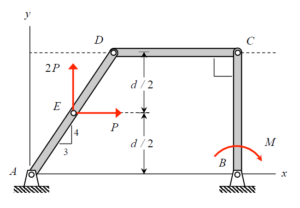Problem statement
Solution video1
Solution video2
DISCUSSION THREAD

Please post questions here on the homework, and take time to answer questions posted by others. You can learn both ways.
Problem statement
Solution video1
Solution video2
DISCUSSION THREAD

You must be logged in to post a comment.
Do I assume that the moment is in the clockwise direction since it's like that in the diagram (since we usually assume that it's in the counterclockwise direction)?
I dont think it matters as much the initial direction you choose for the moment. The answer should give you the proper direction in the end. For example if you kept the moment in the clockwise direction and you got a negative moment, you would know the moment is in the counterclockwise direction.
If we were to say clockwise is positive for the moment and we get a negative answer, should we leave it as negative and say counterclockwise or should we just switch it to positive since we usually assume counterclockwise moment is positive?
Yeah I think we assume it is clockwise
The question says to write the answer as a vector but I'm not to sure how to write the answer as a vector. I'm just getting one value for M.
I think it would be in the k direction. I’m not sure if I’m supposed to be getting a positive or negative answer.
When I equated AD and BC, I received a positive value of M.
Yeah same here, I only solved for the moment at A and B and left it how it is.
Question about these kinds of problems in general. Should you always assume that if there are two joints, which aren't explicitly stated in the problem, that one is a pin joint and the other one is a roller? That's what it looks like in every single practice problem and the solutions for previous hws.
How do you write equilibrium equations for this question? I broke up the machine into three components, then wrote two equilibrium equations for each part (x and y), which left me with 4 nontrivial equilibrium equations. I then wrote three moment equilibrium equations: one for each member by calculating moments from the entire machine.
However, I'm almost certain that either this is the wrong approach or I did something wrong, because I ended up with 0 force exerted on the center bar and 0 force on joint B. Anyone else get something similar?
Not sure if you figured this out, but in case it helps someone, I ran into the same thing. My issue was that I was assuming that there would only be a reaction force along the axis of each link, meaning there would be no x-reaction force at B. When I ran into your situation, I realized that I had no basis for this and there was an x-reaction force at B. I would recommend starting by balancing the moment about A or B, which will give you information about one of the reaction force components, and you can solve along the system from there.
I believe that in this problem joint A and joint B are both pin joints. Usually you can tell if the joint is a pin joint or a roller by the image in the problem statement as the rollers usually look like the joint is on wheels.
Can we assume the distance from D to C is d, because its a square?
Yup that is what I did
I don't believe you can do that since it isn't stated anywhere that it is a square. Also if you start with solving for the force from D to C through the moment at A, you should not need to know that distance to figure out the rest of the problem.
How do we find anything that is in the y-direction? I've been able to find forces in the x direction in terms of M, but nothing in the y. all the equations I am trying have too many variables to solve for.
I didn't find a need to solve for the forces in the y-direction because the moment equations can be set at A and B. Additionally, there turns out to be no y-direction forces at C or D. When a moment equation is taken about point D for member CD, in order to be in equilibrium, the y-direction force on C must be 0 because nothing opposes it.